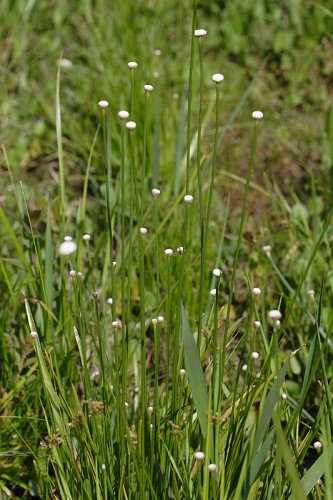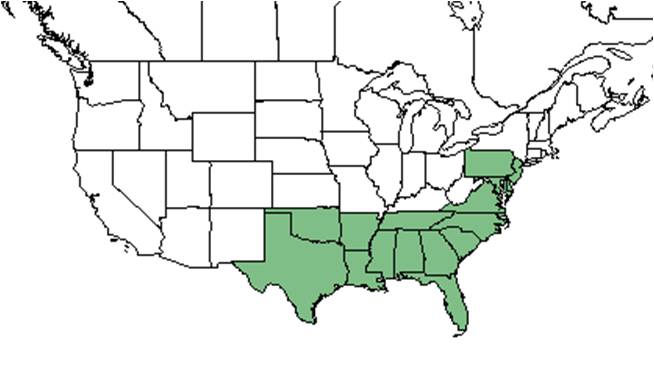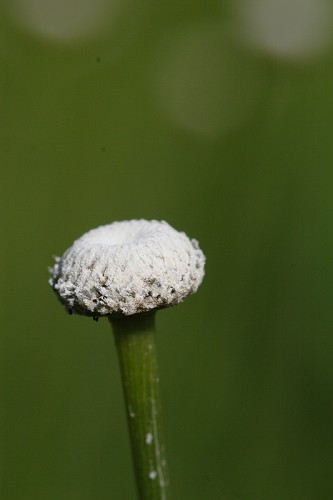Difference between revisions of "Eriocaulon decangulare"
(→Description) |
|||
| Line 25: | Line 25: | ||
==Description== | ==Description== | ||
<!-- Basic life history facts such as annual/perrenial, monoecious/dioecious, root morphology, seed type, etc. --> | <!-- Basic life history facts such as annual/perrenial, monoecious/dioecious, root morphology, seed type, etc. --> | ||
| − | A description of ''Eriocaulon decangulare'' is provided in [http://www.efloras.org/florataxon.aspx?flora_id=1&taxon_id=220004896 The Flora of North America]. | + | A description of ''Eriocaulon decangulare'' is provided in [http://www.efloras.org/florataxon.aspx?flora_id=1&taxon_id=220004896 The Flora of North America]. Flowers of the ''Eriocaulon'' genus are arranged in a crowded head on a long and leafless stalk.<ref name= "lady bird">[[https://www.wildflower.org/plants/search.php?search_field=&newsearch=true]] Lady Bird Johnson Wildflower Center. Accessed: May 9, 2019</ref> |
==Distribution== | ==Distribution== | ||
Revision as of 17:53, 9 May 2019
| Eriocaulon decangulare | |
|---|---|

| |
| Photo by John R. Gwaltney, Southeastern Flora.com | |
| Scientific classification | |
| Kingdom: | Plantae |
| Division: | Magnoliophyta - Flowering plants |
| Class: | Liliopsida – Monocotyledons |
| Order: | Eriocaulales |
| Family: | Eriocaulaceae |
| Genus: | Eriocaulon |
| Species: | E. decangulare |
| Binomial name | |
| Eriocaulon decangulare L. | |

| |
| Natural range of Eriocaulon decangulare from USDA NRCS Plants Database. | |
Common name: Tenangle pipewort
Contents
Taxonomic notes
Varieties: Eriocaulon decangulare Linnaeus var. latifolium Chapman ex Moldenke; Eriocaulon decangulare Linnaeus var. decangulare
Description
A description of Eriocaulon decangulare is provided in The Flora of North America. Flowers of the Eriocaulon genus are arranged in a crowded head on a long and leafless stalk.[1]
Distribution
This species is distributed along the southeastern coastal plain from Pennsylvania and New Jersey south to Florida and west to Oklahoma and Texas.[2] E. decangulare var. decangulare can be found from New Jersey south to southern Florida, west to southwest Arkansas and eastern Texas, and south into Mexico and South America. E. decangulare var. latifolium can be found only in the panhandle of Florida, southern Alabama, and southern Mississippi.[3]
Ecology
Habitat
Habitats of E. decangulare var. decangulare include wet pine flatwoods and savannas, mafic fens and seeps, bogs, wind-tidal marshes, and seasonally flooded pools. As well, E. decangulare var. latifolium can be found in seepage bogs.[3] The species is listed by the USDA Natural Resources Conservation Service as an obligate wetland species that is almost exclusively found in wetland habitats.[2]
Phenology
Generally, E. decangulare flowers from June until October.[3] It has been observed flowering in January and also from March to November with peak inflorescence in June.[4]
Pollination
The following Hymenoptera families and species were observed visiting flowers of Eriocaulon decangulare at Archbold Biological Station: [5]
Colletidae: Hylaeus confluens
Halictidae: Halictus poeyi, Lasioglossum coreopsis, L. nymphalis, L. tamiamensis
Megachilidae: Megachile albitarsis
Sphecidae: Cerceris blakei, Ectemnius rufipes ais, Philanthus ventilabris
Vespidae: Pachodynerus erynnis, Stenodynerus fundatiformis, S. histrionalis rufustus
Conservation and management
This species is listed as extirpated by the Pennsylvania Department of Conservation and Natural Resources, and it is listed as endangered by the Tennessee Department of Environment and Conservation, Natural Heritage Program.[2]
Cultivation and restoration
Photo Gallery
Eriocaulon decangulare Photo by John R. Gwaltney, Southeastern Flora.com
References and notes
- ↑ [[1]] Lady Bird Johnson Wildflower Center. Accessed: May 9, 2019
- ↑ 2.0 2.1 2.2 USDA, NRCS. (2016). The PLANTS Database (http://plants.usda.gov, 9 May 2019). National Plant Data Team, Greensboro, NC 27401-4901 USA.
- ↑ 3.0 3.1 3.2 Weakley, A. S. (2015). Flora of the Southern and Mid-Atlantic States. Chapel Hill, NC, University of North Carolina Herbarium.
- ↑ Nelson, G. PanFlora: Plant data for the eastern United States with emphasis on the Southeastern Coastal Plains, Florida, and the Florida Panhandle. www.gilnelson.com/PanFlora/ Accessed: 9 DEC 2016
- ↑ Deyrup, M.A. and N.D. 2015. Database of observations of Hymenoptera visitations to flowers of plants on Archbold Biological Station, Florida, USA.
